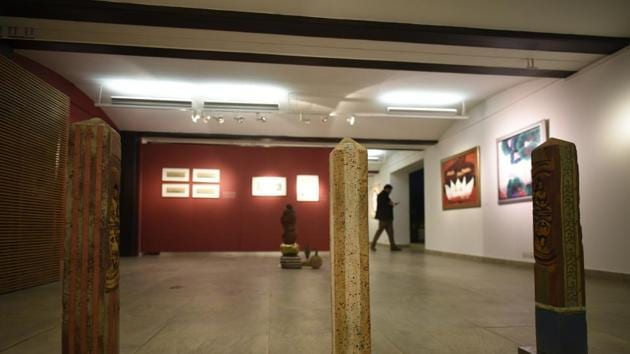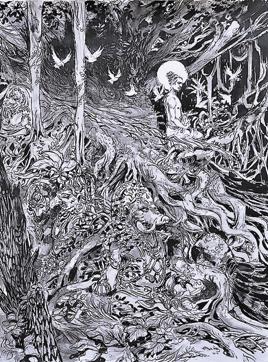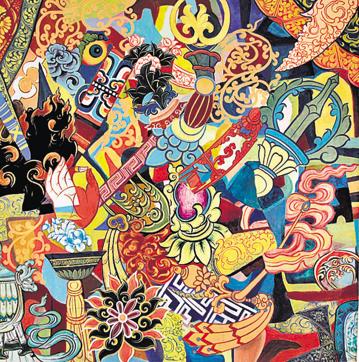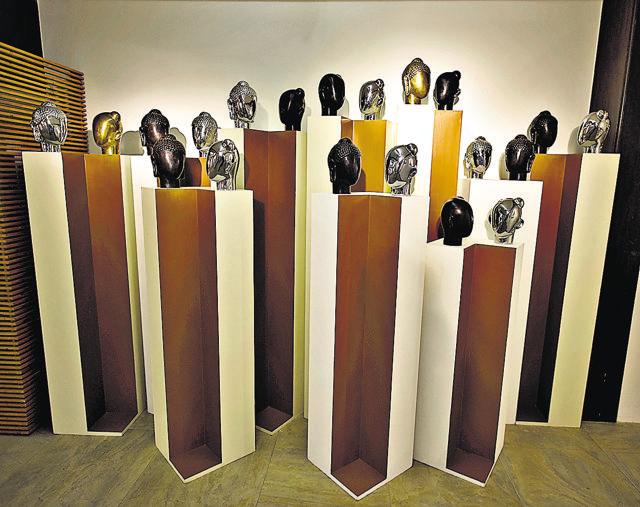Finding the Buddha in you: An exhibition of Buddhist art in town seeks to convey the artists’ spiritual quest
Benevolent Gaze: Buddhist Imprints In Art puts on display a collection of about 50 artworks, comprising paintings, sculpture, ceramics, photography and installations
A huge scroll by Madhubani folk artist Santosh K Das of a musician lost in playing his instrument hangs on a wall. To the right is a photo collage of the Alchi monastery in Leh, captured by acclaimed photographer Aditya Arya. Opposite is a canvas with repetitive pencil lines – the work of a young artist named Deepak Agasthya. Wikipedia defines Buddhist art as “artistic practices that are influenced by Buddhism. It includes art media which depict Buddhas, bodhisattvas, and other entities... as well as physical objects associated with Buddhist practice...”


But Benevolent Gaze: Buddhist Imprints In Art, an ongoing exhibition at Ojas Art gallery, extends the limits of the genre, to include works that reflect a spiritual quest. Which is why Pratap SJB Rana’s brilliant Lotus Budha in vibrant hues – which depicts Buddha meditating – or Bhiksham Dehi – the alms bowl, or Shrinivas Pullagam’s mixed media work titled City Mandala, share gallery space with the depiction of the musician for whom music is a spiritual quest or the line drawings of Agasthya for whom his work is a form of meditation.
On display is a collection of about 50 artworks, comprising paintings, sculpture, ceramics, photography and installations. The list of artists includes both well-known names, like sculptor KS Radhakrishnan, painter-sculptor Satish Gupta, painter Abhishek Singh and photographer Aditya Arya to folk artists like Das, Gond painter Bhajju Shyam and young and upcoming artists like Agasthya and Pullagam.

The exhibition is inspired by “both the message and the practice of Buddhism entering the consciousness of people”. “All the artists, in their own way, depict our journey… making our way to Nirvana through their art and this is what this exhibition is about,” says Anubhav Nath, curatorial director of Ojas Art.
At times, this becomes physical travel – as in the case of Vineet Kacker, who draws inspiration for his ceramic sculptures from the “high Himalayan landscape where he frequently travels, as well as eastern spirituality”. His work Spirit Marker – a series of three ceramic posts with texts and figures etched on them – is a reflection of this travels, both the physical miles demarcated by the kilometre markers and the spiritual journey within.

Similarly, another of his works, which shows a sitting Buddha with a sword on his lap (photo above), communicates the need to cut through all distractions to become one with the moment. While the image of Buddha with a sword may be surprising to many, since the spiritual leader emphasised non-violence, Kacker explains, “Buddhism uses a lot of weapon metaphors. But the idea is not to use it outside - for violence, but within to clean up one’s own being.”
If Kacker’s works are inspired more by the physical space of the Himalayan landscape, KS Radhakrishnan, in his work Mukha Mukham, turns the focus within in a collection of two different heads – one of the Buddha and the other of a commoner – in opaque and chrome finish. “One reflects on the other and gives the feeling of a dialogue. The idea is absorbing the essence of Buddha’s teachings in our daily lives,” explains the sculptor, who did the work a year back.

Also on display are black-and-white paintings by Gond artist Bhajju Shyam, Mahaveer Swami’s depictions of the Buddha in natural pigments and old ink on silk board and a piece which resulted from the collaboration of Isaac Gergan, a contemporary artist and Stanzin Nyentak, a thangka artist, facilitated by the Ladakh Arts and Media Organisation.
End your tour of the exhibition with Arya’s photos of the Alchi monastery, which embodies the artistic and spiritual details of both Buddhism and the Hindu kings of the time. The photos not only present a breathtakingly beautiful image, but also seem to exude that sense of peace and spiritual well-being, which the exhibition, at its core, aims to communicate.
Art Watch
What: Benevolent Gaze: Buddhist Imprints In Art
When: 11 am- 7 pm, till January 14. Closed on Monday
Where: Ojas Art,
1A, Qutub Minar, Mehrauli Road
Nearest metro station: Qutub Minar





